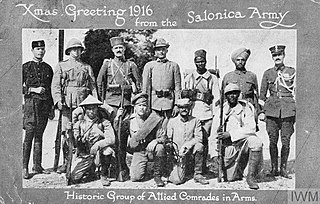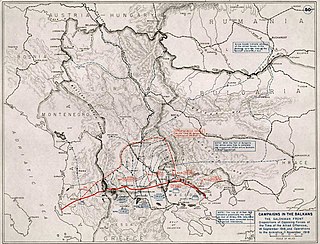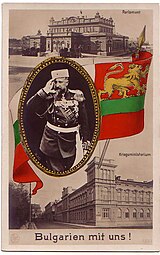
The Central Powers, also known as the Central Empires, were one of the two main coalitions that fought in World War I (1914–1918). It consisted of the German Empire, Austria-Hungary, the Ottoman Empire, and Bulgaria; this was also known as the Quadruple Alliance.

The Entente, or the Allies, were an international military coalition of countries led by France, the United Kingdom, Russia, the United States, Italy, and Japan against the Central Powers of Germany, Austria-Hungary, the Ottoman Empire, and Bulgaria in World War I (1914–1918).

The Serbian campaign was a series of military expeditions launched in 1914 and 1915 by the Central Powers against the Kingdom of Serbia during the First World War.

The Macedonian front, also known as the Salonica front, was a military theatre of World War I formed as a result of an attempt by the Allied Powers to aid Serbia, in the autumn of 1915, against the combined attack of Germany, Austria-Hungary and Bulgaria. The expedition came too late and with insufficient force to prevent the fall of Serbia and was complicated by the internal political crisis in Greece. Eventually, a stable front was established, running from the Albanian Adriatic coast to the Struma River, pitting a multinational Allied force against the Bulgarian army, which was at various times bolstered with smaller units from the other Central Powers. The Macedonian front remained stable, despite local actions, until the Allied offensive in September 1918 resulted in Bulgaria capitulating and the liberation of Serbia.

The Kosovo offensive of 1915 was a World War I offensive launched as part of the Serbian campaign of 1915. It involved the Central Powers and the Kingdom of Serbia.

The Battle of Dobro Pole, also known as the Breakthrough at Dobro Pole, was a World War I battle fought between 15 and 18 September 1918. The battle was fought in the initial stage of the Vardar Offensive, in the Balkans Theatre. On 15 September, a combined force of Serbian, French and Greek troops attacked the Bulgarian-held trenches in Dobro Pole, at the time part of the Kingdom of Serbia. The offensive and the preceding artillery preparation had devastating effects on Bulgarian morale, eventually leading to mass desertions.

The Armistice of Salonica was the armistice signed at 10:50 p.m. on 29 September 1918 between Bulgaria and the Allied Powers at the General Headquarters of the Allied Army of the Orient in Thessaloniki. The armistice came into force at noon on 30 September 1918. The armistice would remain in effect until the conclusion of the Treaty of Neuilly-sur-Seine, the final general peace treaty, in November 1919.

The Kingdom of Bulgaria participated in World War I on the side of the Central Powers from 14 October 1915, when the country declared war on Serbia, until 30 September 1918, when the Armistice of Salonica came into effect.

Although a member of the Triple Alliance, Italy did not join the Central Powers – Germany and Austria-Hungary – when the war started with Austria-Hungary's declaration of war on Serbia on 28 July 1914. In fact, the two Central Powers had taken the offensive while the Triple Alliance was supposed to be a defensive alliance. Moreover the Triple Alliance recognized that both Italy and Austria-Hungary were interested in the Balkans and required both to consult each other before changing the status quo and to provide compensation for whatever advantage in that area: Austria-Hungary did consult Germany but not Italy before issuing the ultimatum to Serbia, and refused any compensation before the end of the war.

At the outbreak of World War I in August 1914, the Kingdom of Greece remained neutral. Nonetheless, in October 1914, Greek forces once more occupied Northern Epirus, from where they had retreated after the end of the Balkan Wars. The disagreement between King Constantine, who favoured neutrality, and the pro-Allied Prime Minister Eleftherios Venizelos led to the National Schism, the division of the state between two rival governments. Finally, Greece united and joined the Allies in the summer of 1917.

The Noemvriana of December [O.S. November] 1916, or the Greek Vespers, was a political dispute which led to an armed confrontation in Athens between the royalist government of Greece and the forces of the Allies over the issue of Greece's neutrality during World War I.

The Vardar offensive was a World War I military operation, fought between 15 and 29 September 1918. The operation took place during the final stage of the Balkans Campaign. On September 15, a combined force of Serbian, French and Greek troops attacked the Bulgarian-held trenches in Dobro Pole, at the time part of Serbia. The assault and the preceding artillery preparation had devastating effects on Bulgarian morale, eventually leading to mass desertions.

In World War I, Albania had been an independent state, having gained independence from the Ottoman Empire on 28 November 1912, during the First Balkan War. It was recognised by the Great Powers as the Principality of Albania, after Turkey officially renounced all its rights in May 1913. Being a fledgling new country, it quickly unravelled and just a few months after taking power, its German ruler, Prince Wilhelm, was forced to flee. After World War I broke out, anarchy took hold of the country as tribes and regions rebelled against central rule. To protect the Greek minority, Greek control was established in the southern districts replacing the Northern Epirote units beginning in October 1914. In response to this, Italy, although officially neutral at the time, also sent troops into the port of Vlorë, while Serbia and Montenegro took control of northern regions. In 1915 Serbia was overrun by combined German, Austro-Hungarian, and Bulgarian forces; the Serbian army retreated across the mountain passes of northern Albania, towards the Adriatic. Italian troops drove the Greeks from southern Albania and brought almost all Albanian territory under their control. Austrian forces invaded in June 1916; Austro-Hungarian forces remained in Albania until the end of the war when a multinational Allied force broke through and pushed them out in 1918.

The Battle of Krivolak was a World War I battle, fought between 21 October and 22 November 1915. It was fought in the initial stage of the Macedonian campaign, in the Balkans Theatre. On 21 October, Bulgarian troops attacked the French-held positions near the Strumica rail station, at the time part of the Kingdom of Serbia, starting the battle. Fighting continued until 22 November, when two Serbian divisions failed to capture Skopje, thus rendering the continuation of Entente offensive operations dangerous and forcing the French to evacuate their forces from the region.

The Austro-Hungarian Armed Forces occupied Serbia from late 1915 until the end of World War I. Austria-Hungary's declaration of war against Serbia on 28 July 1914 marked the beginning of the war. After three unsuccessful Austro-Hungarian offensives between August and December 1914, a combined Austro-Hungarian and German offensive breached the Serbian front from the north and west in October 1915, while Bulgaria attacked from the east. By January 1916, all of Serbia had been occupied by the Central Powers.

The Great Retreat, also known in Serbian historiography as the Albanian Golgotha, refers to the retreat of the Royal Serbian Army through the mountains of Albania during the 1915–16 winter of World War I.

The Battle of Kosturino was a World War I battle fought between 6 and 12 December 1915. It was fought in the initial stage of the Macedonian campaign, in the Balkans Theatre. On 6 December, Bulgarian troops attacked the French and British-held trenches in Kosturino, at the time part of the Kingdom of Serbia. Though the early offensive was held in check, on 8 December, Bulgaria managed to infiltrate the Memesli ravine. Bulgaria then seized Crete Simonet, thus threatening to outflank the Allies. The Entente defeat at Kosturino led to the complete withdrawal of Allied forces from Serbia, thus enabling the Central Powers to build the Berlin to Constantinople rail line. In the meantime, the Allies concentrated on solidifying their defenses in Greece.

The Liberation of Serbia, Albania and Montenegro was a military action in the Balkans in the final weeks of World War I. Between 29 September and 11 November 1918, the Allied Army of the Orient liberated these three countries from occupation by the Central Powers.

The Bulgarian occupation of Serbia during World War I started in Autumn 1915 following the invasion of Serbia by the combined armies of Germany, Austria-Hungary and Bulgaria. After Serbia's defeat and the retreat of its forces across Albania, the country was divided into Bulgarian and Austro-Hungarian occupation zones.

The Serbian campaign of 1915 refers to a military campaign carried out by the Central Powers, primarily Germany, Austria-Hungary and Bulgaria, against the Kingdom of Serbia during World War I. The campaign took place from October to November 1915.
























